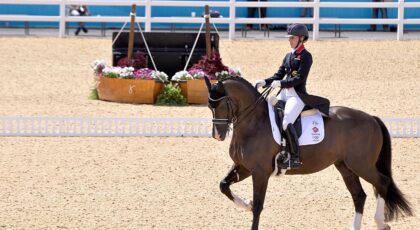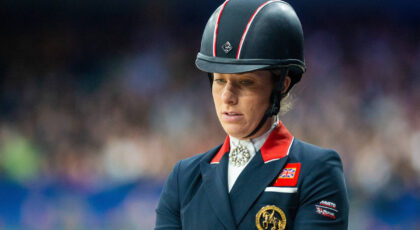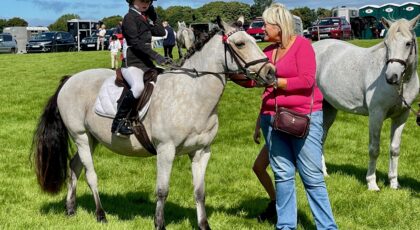The most asked question in the equine world is: “Why does my horse sometimes refuse to do what I ask him to do?” No matter what situation is occurring the problem is always some form of horse resistance and the solution is always some form of human leadership.
The horse is a prey animal. He is born hard-wired to judge everything based on how it affects his self-preservation. Therefore, if he resists our request, his refusal is always motivated by his most dominant instinctual trait: survival. From his point of view, his decision to resist is logical, rational, and intelligent. Not only does he believe he’s doing the right thing by saying “no” to us, he doesn’t understand why we’re arguing with him.
In the natural world, horses have leaders and live in herds. Their leader must have and demonstrate superior survival skills. They must be the most intelligent, confident, perceptive, and sensitive. They must have acquired the most survival experience and, therefore, the most wisdom. In a herd of horses, this is known as the Alpha. There is always an Alpha or leader whether it is a herd of 100 horses or a herd of two—you and your horse.
In a herd of two, if a horse does not perceive his human, male or female, as possessing these Alpha leadership qualities, he will not feel totally safe and, therefore, not accept his rider as his leader. The horse will then rely on himself. He’ll be his own leader, constantly evaluate and challenge some or every request his rider makes.
If the horse decides a request is in the best interest of his survival, he will comply. Sometimes this creates the illusion that you, the rider are in control. However, if for any reason the horse has the slightest doubt, he will resist and attempt to do what he believes is more in his best interest of self-preservation. To his rider, this appears as refusal or disobedience. To the horse, it’s a matter of life and death. There are usually four reasons a horse will resist or say no to his rider: fear, disrespect, misunderstanding, and pain. The basis for each one is survival.
Fear
Horses are prey animals. Their life depends on never putting themselves in a place or situation where they could be eaten by a predator. From their point of view, it doesn’t matter if it’s on the plains of Idaho or in a beautiful arena on Florida. Everything horses do for humans occurs only after they know they’re safe. Until then, they are hardwired to immediately run or resist if they sense perceived danger.
Leaders never use force.
If a horse believes a specific request from his rider may jeopardize his survival (i.e. crossing a stream) and he does not accept his rider as his leader, he will be fearful and resist the request. However, if he looks to and trusts his rider as his leader, he will know his rider (like the Alpha horse) would never do anything to jeopardize his safety. He will then, though still anxious, allow his rider to help him become more confident, overcome his initial fear, and eventually follow the rider’s request. This can only be accomplished with communication, not force. Leaders never use force.
Disrespect
For a horse to choose another as his leader and entrust his life to them, he must respect everything about them: intelligence, ability, trustworthiness, and wisdom. This is true whether it’s you or another horse. Horses are just like humans; we can’t gain their respect by asking for or demanding it. We can only earn it. If our horse does not respect us, he will decide what he’s going to do or not do. Good leaders, whether horse or human, know how to communicate effectively and have the tools and techniques necessary to earn and establish respect.
Even when we are the chosen leader and have earned our horses respect, it is their nature to continually test us to see if we still deserve it.
Sometimes it may seem like our horse respects us because he’s doing what we’re asking when in fact he’s just going along or putting up with us because what we’re asking isn’t that important to him. This again creates the illusion of being in control and is a set up for potential problems. Even when we are the chosen leader and have earned our horses respect, it is their nature to continually test us to see if we still deserve it. Humans with fabulously responsive horses are often surprised when “for no reason” their horse resists some routine request. Respect is not only something we earn; it must also be maintained.
Misunderstanding
Horses don’t speak English and force is not a language. Like humans, they respond to clear communication. If we want our horse to do something, it’s our responsibility to communicate in a way he understands. Sometimes if we ask our horse to go from a trot to a canter and he doesn’t, we blame him for being disrespectful, willful, or lazy. In fact, he maybe none of these. If he loves, trusts, and respects us as his leader, he knows complying with our request is also in his best interest of self-preservation. His non-responsiveness can then be an indication that he doesn’t understand our cues or our way of communicating.
Good leaders provide good communication.
Sometimes if we have not been clear in our communication, our horse may do something other than what we requested but think he is doing what we asked for. Again, when this happens many traditional riders think their horse is resisting. They become annoyed and see the horse as the problem. If, however, the rider knows his horse accepts him as his leader, he can then look at himself as the potential problem, reconsider the quality of his communication, and make the appropriate change (i.e. be lighter, be firmer, release his pressure faster etc.). Good leaders provide good communication.
Pain
Horses, like many other animals, are amazing at tolerating physical pain. What else can they do? Any request by the rider that causes or adds to their physical pain increases their vulnerability and, therefore, threatens their self-preservation. If pain is associated with the rider, resistance will always occur whether a horse accepts him as his leader or not.
Being a good leader includes learning how to tell when our horse is in pain and how to help him. Horses are constantly telling us about themselves with their bodies, eyes, head, tail, and feet. They’re either moving or still, standing or lying down. If we learn what they usually do when they’re happy and healthy, hopefully, we’ll be able to tell when they’re not (i.e. if they’re not eating, something is usually wrong).
Before we saddle our horse, much less sit on him, it’s important to check him out physically. We need to have him move to see if he looks comfortable and sound; palpate his back and his legs for soreness. Horses often hide their pain. It’s instinctual and a matter of survival. The weak or injured horse is usually the first choice of a predator. As the leader, it is always our responsibility to make sure our horse is not in pain.
Whether it’s fear, disrespect, misunderstanding, or pain, all equine resistance is initially motivated by self-preservation.
One of the most overlooked areas of serious pain in horses is their teeth. Sometimes when a horse resists his rider’s request or exhibits physical difficulty, such as turning to the left or right, he is trying to tell his rider he’s in pain. Sometimes the pain is in his mouth. If you were a horse with a toothache how would you ask for help? All domestic horses need to be examined annually by a qualified equine dentist. Good leaders know this and do this for their horse.
Whether it’s fear, disrespect, misunderstanding, or pain, all equine resistance is initially motivated by self-preservation. Seeing this from the horses’ point of view not only makes perfect sense but, given the same circumstances, we humans would probably behave the same way. The positive acceptance and execution of our requests by our horses is only possible when we have earned their love, trust, and respect and are truly recognized by them as their leader of our herd of two.
Then instead of blaming our horse and becoming angry, frustrated, and disappointed when he resists our request we can say: “My horse is telling me something about the quality of my leadership. What could I have done differently to be more effective? Do I need to help him or myself do something to become more confident, earn or regain his respect, improve my communication or cues (be gentler or firmer) or do I need to make sure he’s not in any pain.”
Becoming a horse’s leader is most effectively established on the ground. Horses naturally interact with other horses on the ground. Horses don’t ride other horses. Natural Horsemanship is based on what is most natural and understandable for the horse. It provides the tools and techniques that enable humans to establish themselves as their horses’ leader before they get on their back. Riding your horse before you’re his leader is not only a set up for resistance; it’s the reason riders get hurt. Today’s world renowned Spanish Riding School, established in 1572, requires their students to work with their horses on the ground for the first four years of their eight-year program before they are allowed to begin their riding.
What is truly amazing and transformative is that knowing if our horse says “No” it’s actually a wonderful opportunity to learn something important and helpful. What we thought was our horse doing something wrong, turns out to be him helping us become a better rider and a better horseman in a way we might never have learned as well from a human teacher. Then we realize that our horse, our ultimate teacher, will always let us know how we’re doing, what we need to improve and how to be a better rider.
 About the Author
About the Author
Tim Hayes is the author RIDING HOME: The Power of Horses to Heal. It is this amazing power of horses to heal and teach us about ourselves that is accessible to everyone and found in the pages this book. Every book ordered will benefit veterans with PTSD, children with autism, and children of families in need. Learn more at ridinghome.com. For Tim’s clinics, private sessions, books, DVD’s and more articles go hayesisforhorses.com.




 July 2, 2016
July 2, 2016 



























